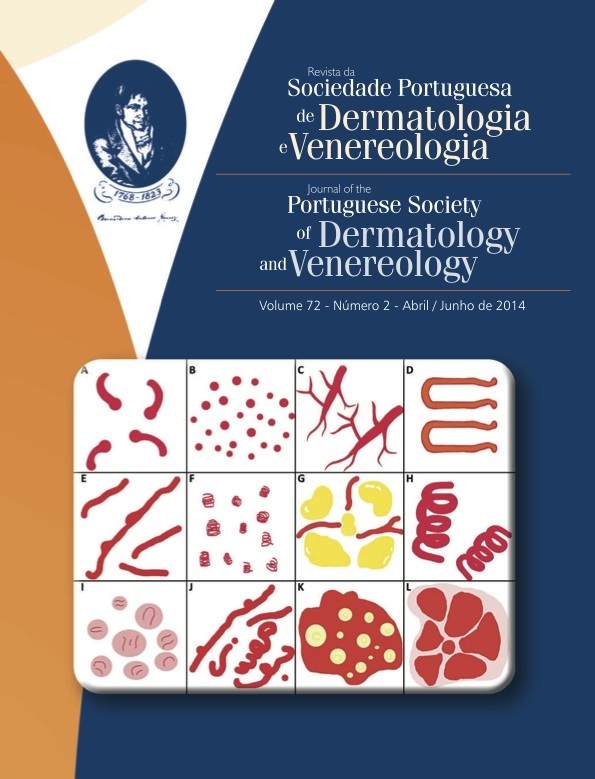Eficácia e segurança de mebutato de ingenol no tratamento da queratose actínica: Revisão sistemática e meta-análise.
Resumo
Introdução: A queratose actínica é a lesão pré-maligna mais frequente. A abordagem terapêutica dos doentes com múltiplas lesões envolve terapêuticas de campo.Objetivo: Avaliar a eficácia e segurança de mebutato de ingenol, um novo medicamento destinado à terapêutica tópica de campo.
Desenho: Revisão sistemática e meta-análise dos ensaios clínicos controlados e aleatorizados (RCTs).
Fontes bibliográficas: Medline e Cochrane Library (junho 2014).
Seleção dos estudos: A seleção e avaliação dos RCTs foram feitas de forma independente.
Análise quantitativa: Meta-análise de efeitos aleatórios. A heterogeneidade foi avaliada com o teste I2 .
Resultados: Foram incluídos 6 ensaios (n=1.492) versus placebo. Mebutato de ingenol esteve associado a uma possibilidade de um doente ter remoção completa das lesões 17 (IC95%: 9 a 31; I2=0%) e 8,5 (IC95%: 5 a 15; I2=0%) vezes superior, comparativamente ao placebo, no rosto/couro cabeludo e no tronco/extremidades, respetivamente. A incidência de eventos adversos relacionados com o tratamento foi superior no grupo mebutato de ingenol (+23%, IC95%: 11 a 35%), sem diferenças entre grupos na taxa de abandono por eventos adversos.
Conclusões: Mebutato de ingenol é eficaz no tratamento da queratose actínica. Comparativamente às restantes terapêuticas de campo disponíveis em Portugal, o seu valor terapêutico advém do favorável perfil de segurança e tolerabilidade, da simplicidade e curta duração do esquema terapêutico e da possibilidade de tratar de forma diferenciada as lesões de acordo com a localização anatómica (individualização da terapêutica).Estudos futuros deveriam comparar diretamente as diferentes opções terapêuticas e avaliar a efetividade das mesmas no mundo real.
Downloads
Referências
Rosen T, Lebwohl MG. Prevalence and awareness of actinic keratosis: Barriers and opportunities. J Am Acad Dermatol. 2013; 68(1 Suppl 1):S2-9.
Glogau RG. The risk of progression to invasive disease. J Am Acad Dermatol. 2000; 42(1 Pt 2):23-4.
Dodson JM, DeSpain J, Hewett JE, Clark DP. Malignant potential of actinic keratoses and the controversy over treatment. A patient-oriented perspetive. Arch Dermatol. 1991; 127(7):1029–1031.
Fuchs A, Marmur E. The kinetics of skin cancer: progression of actinic keratosis to squamous cell carcinoma. Dermatol Surg. 2007; 33(9):1099-101.
Cockerell CJ. Histopathology of incipient intraepidermal squamous cell carcinoma ("actinic keratosis"). J Am Acad Dermatol. 2000; 42(1 Pt 2):11-7.
Röwert-Huber J, Patel MJ, Forschner T, Ulrich C, Eberle J, Kerl H et al. Actinic keratosis is an early in situ squamous cell carcinoma: a proposal for reclassification. Br J Dermatol. 2007; 156 Suppl 3:8-12.
Williams H, Svensson A, Diepgen T, Naldi L, Coenraads PJ, Elsner P et al.; European Dermato-Epidemiology Network (EDEN). Epidemiology of skin diseases in Europe. Eur J Dermatol. 2006; 16(2):212-8.
Lucas R, McMichael T, Smith W, Armstrong B. Solar ultraviolet radiation- global burden of disease from solar ultraviolet radiation- WHO report. 2006. Report No.: Environmental Burden of Disease Series N 13.
Massa A, Alves R, Amado J, Matos E, Sanches M, Selores M et al. [Prevalence of cutaneous lesions in Freixo de Espada à Cinta]. Ata Med Port. 2000; 13(5-6):247-54
de Berker D, McGregor JM, Hughes BR; British Association of Dermatologists Therapy Guidelines and Audit Subcommittee. Guidelines for the management of actinic keratoses. Br J Dermatol. 2007; 156(2):222-30.
Stockfleth E, Terhorst D, Braathen L, Cribier B, Cerio R, Ferrandiz C et al., on behalf of the European Dermatology Forum. European Dermatology Forum. [Online]; 2010 [citado a: 2012 10 25. Disponível a partir: http://www.euroderm.org/images/stories/guidelines/guideline_Management_Actinic_Keratoses-update2011.pdf.
Stockfleth E, Ferrandiz C, Grob JJ, Leigh I, Pehamberger H, Kerl H; European Skin Academy. Development of a treatment algorithm for actinic keratoses: a European Consensus. Eur J Dermatol. 2008; 18(6):651-9.
European public assessment report (EPAR) do Picato®, disponível em http://www.ema.europa.eu/docs/pt_PT/document_library/EPAR_-_Product_Information/human/002275/WC500135327.pdf (Acedido em 2/07/2014)
Liberati A, Altman DG, Tetzlaff J, Mulrow C, Gøtzsche PC, Ioannidis JP et al. The PRISMA statement for reporting systematic reviews and meta-analyses of studies that evaluate healthcare interventions: explanation and elaboration. BMJ. 2009; 339:b2700.
Altman DG, Sterne JAC. Chapter 8: assessing risk of bias in included studies. In: Higgins JPT, Green S. eds. Cochrane handbook for systematic reviews of interventions version 5.1.0 (updated March 2011). The Cochrane Collaboration, 2011. Disponível a partir de http://handbook.cochrane.org/
Cochrane Review Manager Software. Version 5.2. Disponível a partir: http://tech.cochrane.org/Revman.
Higgins JPT, Thompson SG, Deeks JJ, Altman DG. Measuring inconsistency in meta-analyses. BMJ 2003; 327:557–560.
DerSimonian R, Laird N. Meta-analysis in clinical trials. Controlled Clinical Trials 1986; 7:177-188.
Berman B, Goldenberg G, Hanke CW, Tyring SK, Werschler WP, Knudsen KM et al. Efficacy and safety of ingenol mebutate 0.015% gel after cryosurgery of actinic keratosis: 12-month results. J Drugs Dermatol. 2014; 13(6):741-7.
Neidecker MV, Davis-Ajami ML, Balkrishnan R, Feldman SR. Pharmacoeconomic considerations in treating actinic keratosis. Pharmacoeconomics. 2009; 27(6):451-64.
Tinghög G, Carlsson P, Synnerstad I, Rosdahl I. Societal cost of skin cancer in Sweden in 2005. Ata Derm Venereol. 2008; 88(5):467-73.
Australian Institute of Health and Welfare. Health system expenditures on cancer and other neoplasms in Australia, 2000-01. Canberra: Australian Institute of Health and Welfare; 2005.
Serup J, Lindblad AK, Maroti M, Kjellgren KI, Niklasson E, Ring L et al. To follow or not to follow dermatological treatment--a review of the literature. Ata Derm Venereol. 2006; 86(3):193-7.
Ceilley RI, Jorizzo JL. Current issues in the management of actinic keratosis. J Am Acad Dermatol. 2013; 68(1 Suppl 1):S28-38.
Lebwohl M, Shumack S, Stein Gold L, Melgaard A, Larsson T, Tyring SK. Long-term follow-up study of ingenol mebutate gel for the treatment of actinic keratoses. JAMA Dermatol. 2013; 149(6):666-70.
Bettencourt MS. Use of ingenol mebutate gel for actinic keratosis in patients in a community dermatology practice. J Drugs Dermatol. 2014; 13(3):269-73.
Gupta AK, Paquet M, Villanueva E, Brintnell W. Interventions for actinic keratoses. Cochrane Database Syst Rev. 2012 Dec 12;12:CD004415
Gupta AK, Paquet M. Network meta-analysis of the outcome 'participant complete clearance' in nonimmunosuppressed participants of eight interventions for actinic keratosis: a follow-up on a Cochrane review. Br J Dermatol. 2013; 169(2):250-9.
Todos os artigos desta revista são de acesso aberto sob a licença internacional Creative Commons Attribution-NonCommercial 4.0 (CC BY-NC 4.0).








